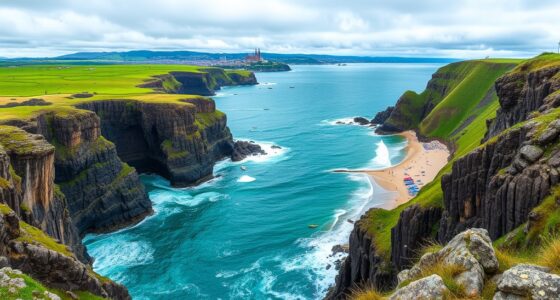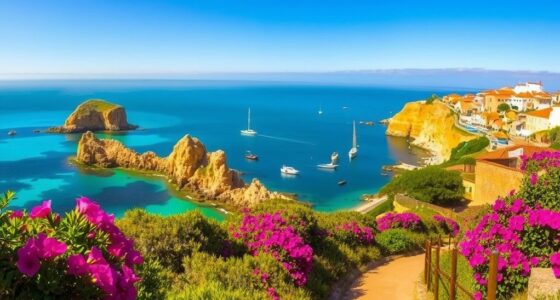Scotland’s islands, including Skye and the Hebrides, are full of dramatic landscapes, historic castles, and rich wildlife. You can explore rugged coastlines, hike scenic trails, and spot seabirds, whales, and red deer. Be sure to experience local culture with traditional music, Gaelic stories, and charming villages. For unforgettable adventures and hidden secrets, continue exploring these mesmerizing islands and their timeless beauty.
Key Takeaways
- Skye features dramatic landscapes like the Old Man of Storr, rugged coastlines, and historic sites such as Dunvegan Castle.
- The Hebrides comprise a diverse archipelago with isolated islands, pristine beaches, and vibrant wildlife like puffins and seals.
- Both regions offer outdoor activities including hiking, wildlife watching, sailing, and exploring cultural festivals and Gaelic traditions.
- Accessible via ferries and flights, these islands provide unique scenic beauty, historic landmarks, and authentic Scottish coastal communities.
- Sustainable tourism, respecting local heritage, and supporting community crafts are essential for preserving the islands’ natural and cultural charm.
Exploring the Natural Wonders of Skye
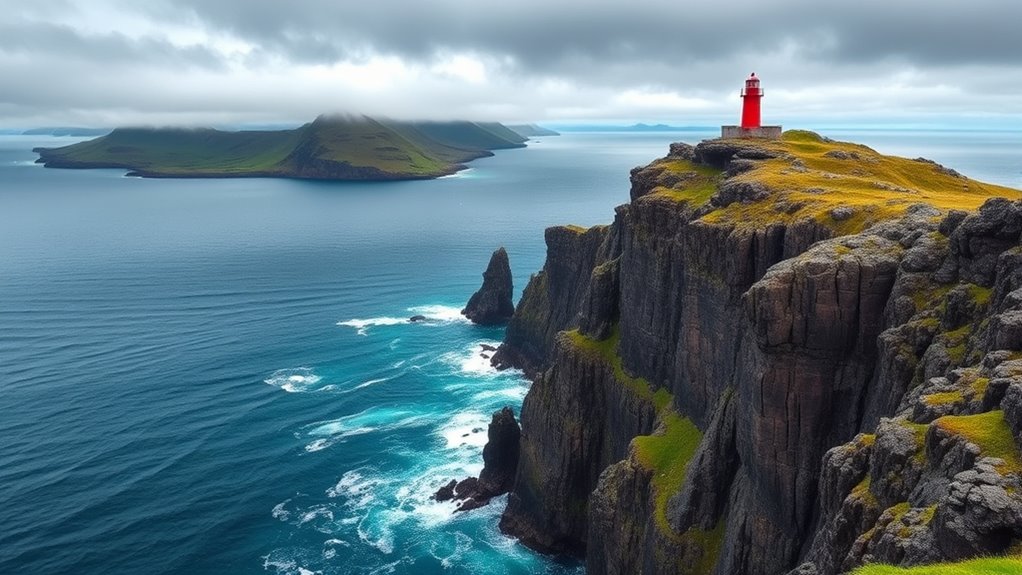
Have you ever wondered what makes Skye’s landscape so breathtaking? It’s the dramatic scenery shaped by nature’s forces. Towering cliffs, like the Old Man of Storr, rise sharply against the sky, offering stunning views and fantastic hiking opportunities. The rugged coastline features hidden coves, secluded beaches, and sea stacks that seem to pierce the ocean. You’ll find lush green valleys, such as Quiraing, carved by ancient landslides, creating otherworldly landscapes. Waterfalls cascade down moss-covered rocks, adding to the island’s mystical charm. The combination of rocky outcroppings, vibrant flora, and expansive skies creates a visual feast. Skye’s natural wonders invite you to explore, photograph, and immerse yourself in the untouched beauty of this remarkable island. Additionally, the island’s diverse terrain exemplifies how geological processes have contributed to its unique topography. Understanding tectonic activity helps explain the dramatic features observed across Skye’s terrain. Moreover, natural formations like sea stacks and arches further highlight the power of erosion shaping the landscape.
Iconic Landmarks and Historic Sites on Skye
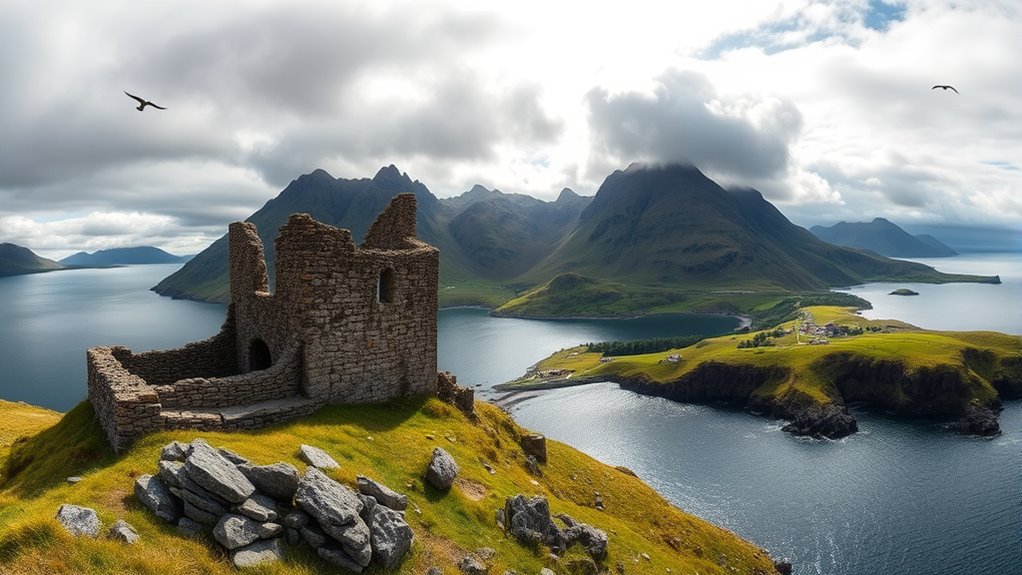
Skye’s stunning landscapes are complemented by a wealth of iconic landmarks and historic sites that reveal the island’s rich cultural heritage. You’ll want to visit Dunvegan Castle, the oldest continuously inhabited castle in Scotland, to explore its impressive towers and learn its fascinating history. The Quiraing offers breathtaking views and rugged terrain, perfect for hiking and photography. Don’t miss the Talisker Distillery, where you can sample renowned single malt whisky and discover the distillation process. The Old Man of Storr stands tall as a striking rock formation, often featured in photos of the island. Additionally, the ruined Eilean Donan Castle nearby adds to the historic charm of the region. These landmarks give you a glimpse into Skye’s storied past and enduring cultural significance.
Wildlife Encounters in the Hebrides
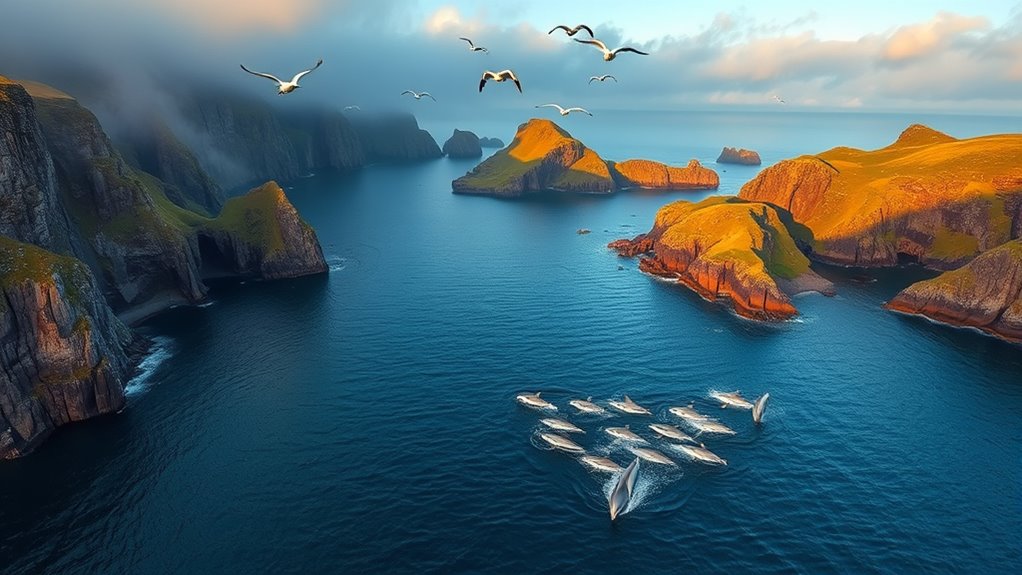
Are you enthusiastic to experience Scotland’s diverse and vibrant wildlife? The Hebrides offer incredible opportunities to see rare and fascinating species. You might spot golden eagles soaring high above, their majestic wings spanning wide as they hunt for prey. Seabirds, including puffins, razorbills, and guillemots, nest along rugged cliffs and rocky shores, providing spectacular birdwatching moments. On land, red deer graze peacefully in remote forests, while otters play in coastal waters. The waters surrounding the islands are teeming with marine life, such as seals and dolphins, which often leap and surf near the boat. Visiting during the right season increases your chances of encountering these creatures. Engaging with local wildlife conservation efforts can enhance your understanding and appreciation of these species. Supporting wildlife protection initiatives helps preserve these incredible habitats for future generations. The presence of marine biodiversity further enriches the ecological tapestry of the Hebrides, offering more opportunities for wildlife encounters. Additionally, educating oneself about ecological significance can deepen your connection to these natural environments. With patience and a keen eye, you’ll witness Scotland’s wild side in its full, enthralling glory around the Hebrides.
Coastal Walks and Hiking Trails in the Islands
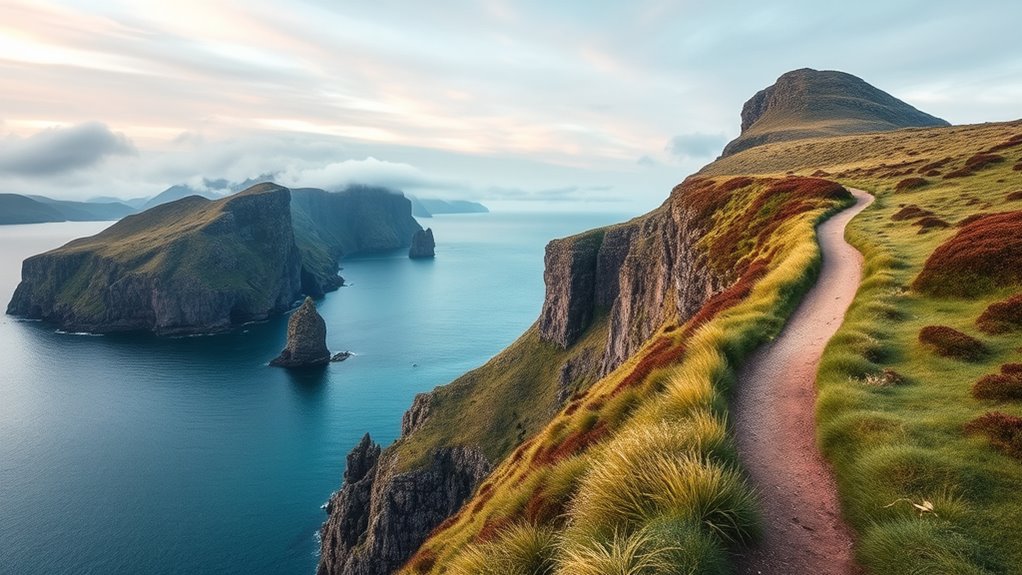
Exploring the rugged coastlines and scenic trails of Scotland’s islands offers an unforgettable way to experience their natural beauty. As you hike, you’ll encounter breathtaking views, hidden coves, and dramatic cliffs. Whether you’re after a gentle stroll or a challenging trek, the islands have options for all levels. You might find yourself walking along coastal paths with panoramic ocean vistas or winding through lush, wild landscapes. The fresh sea breeze and bird calls create an immersive experience. Additionally, some routes may have variable opening hours, so planning ahead ensures a smooth adventure. Being aware of local regulations can also enhance your safety and enjoyment during your exploration. Knowing about accessible pathways can help tailor your journey to your preferences and needs. To make the most of your trip, it’s helpful to be familiar with public transportation options, especially in remote areas.
Cultural Heritage and Traditions of the Hebrides

Have you ever wondered how the Hebrides’ rich history and vibrant traditions continue to shape their communities today? You’ll find that Gaelic culture, music, and storytelling remain central to island life. Festivals celebrate ancient customs, like the Highland games or local ceilidh dances, where everyone joins in. You’ll also notice traditional crafts such as tweed weaving and Gaelic singing still thrive. To see this in action, check out the table below:
| Tradition | Significance |
|---|---|
| Gaelic Language | Preserves cultural identity and storytelling heritage |
| Ceilidh Dances | Foster community spirit and cultural expression |
| Highland Games | Celebrate strength, history, and local pride |
These traditions keep the islands vibrant, connecting past and present in everyday life. You may also observe how cultural continuity plays a key role in strengthening community bonds and fostering a sense of belonging among residents. Recognizing the resilience of these traditions highlights the importance of cultural preservation in maintaining the islands’ unique identity. Additionally, efforts to support traditional craftsmanship ensure that these skills are passed down through generations, enriching the cultural landscape.
Unique Villages and Settlements to Discover
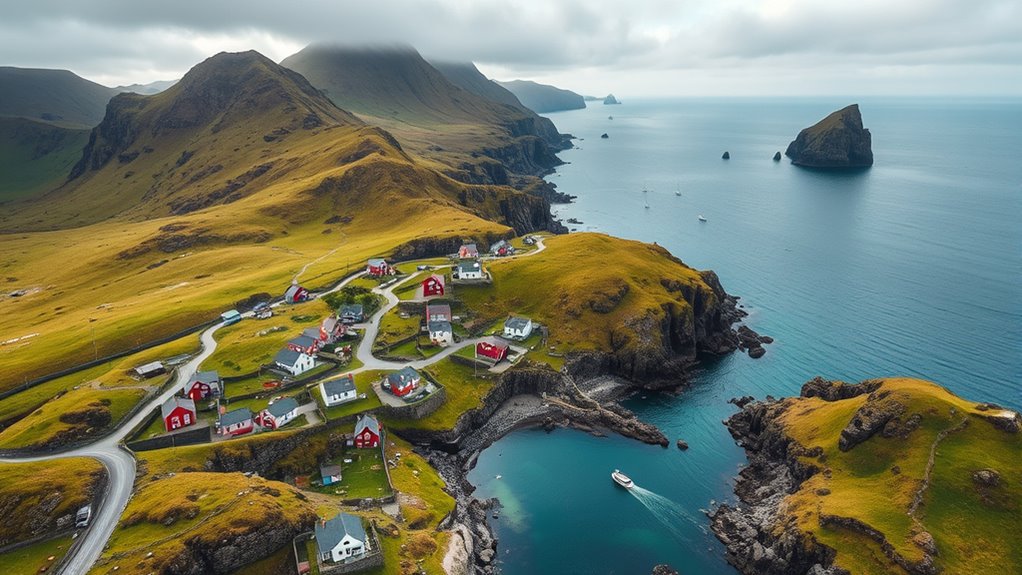
As you explore Scotland’s islands, you’ll encounter charming coastal hamlets that seem frozen in time, perfect for quiet strolls. You’ll also find historic fishing villages that tell stories of a bygone era, with lively harbors and traditional crafts. For those seeking solitude, remote mountain settlements offer breathtaking views and a true sense of escape. Additionally, some destinations boast scenic views, enhancing their appeal to visitors seeking natural beauty. Many of these villages utilize self watering plant pots in their community gardens to maintain greenery with minimal effort, reflecting sustainable practices and innovative gardening techniques.
Quaint Coastal Hamlets
Nestled along Scotland’s rugged coastlines, quaint coastal hamlets offer a glimpse into timeless charm and local life. As you wander through these tiny villages, you’ll notice their colorful cottages, narrow winding streets, and friendly faces. These hamlets exude a peaceful atmosphere that invites you to slow down and soak in the scenery. You might find yourself enjoying:
- Fresh seafood from local fishermen
- Cozy cafes with homemade treats
- Seaside walks with stunning views
- Traditional stone cottages
- Small craft shops showcasing local artistry
Each hamlet tells a story of centuries-old traditions and a close-knit community. Exploring these peaceful spots lets you experience authentic Scottish coastal life, far from busy tourist hubs, offering a true taste of island heritage. Somatic therapy techniques such as mindful movement and breathwork can help visitors connect more deeply with the calming surroundings during their stay. Additionally, understanding the history of pinball machines can add an interesting layer to your appreciation of local gaming culture, which has been influenced by community engagement through shared recreational spaces. Many of these hamlets also feature dog-friendly areas, making it easy to explore with your My dog names while enjoying the scenic beauty.
Historic Fishing Villages
Moving beyond the charming coastal hamlets, Scotland’s historic fishing villages offer a mesmerizing glimpse into the country’s maritime past. As you explore these villages, you’ll notice the weathered harbors, narrow cobbled streets, and traditional cottages that tell stories of generations of fishermen. Many villages still retain their authentic character, with fishing boats bobbing in the waters and local seafood markets bustling with fresh catches. You can wander through narrow alleyways, discovering ancient boat sheds and historic lighthouses that once guided sailors home. These villages often host lively festivals celebrating maritime heritage, giving you a chance to experience local traditions firsthand. Visiting these spots, you’ll gain a deep appreciation for Scotland’s seafaring history and the resilient communities that thrived on the ocean’s bounty. Preserving cultural heritage is essential to maintaining the unique charm of these historic villages, especially in the face of increasing community resilience initiatives that aim to support local traditions and sustainability. Additionally, many of these villages are actively involved in cultural preservation efforts to safeguard their distinctive character for future generations. Promoting sustainable tourism is also key to ensuring these areas can be enjoyed by visitors without compromising their authenticity.
Remote Mountain Settlements
Remote mountain settlements in Scotland beckon travelers seeking solitude and stunning natural beauty. These hidden gems offer a peaceful escape from bustling towns, surrounded by rugged landscapes and untouched wilderness. As you explore, you’ll discover villages where time seems to stand still, with charming stone cottages and narrow paths. These settlements often sit high in the hills or tucked away in remote valleys, providing breathtaking views and a sense of isolation. Visiting such places connects you with traditional Scottish life and local stories.
- Experience quiet mornings with panoramic mountain views
- Spot wildlife like red deer and golden eagles
- Meet welcoming locals preserving ancient customs
- Hike scenic trails that lead to breathtaking overlooks
- Enjoy fresh, locally sourced food in cozy cafes
- Learning about traditional Scottish life can deepen your appreciation for these remote communities.
- Recognizing the importance of AI safety measures is essential when exploring remote areas with modern technology.
- Familiarity with Gold IRA Rollovers can be beneficial when planning long-term financial security during your travels.
Additionally, understanding camping gear suited for rugged environments can enhance your experience in these remote settings.
Marine Life and Water Activities Around the Islands
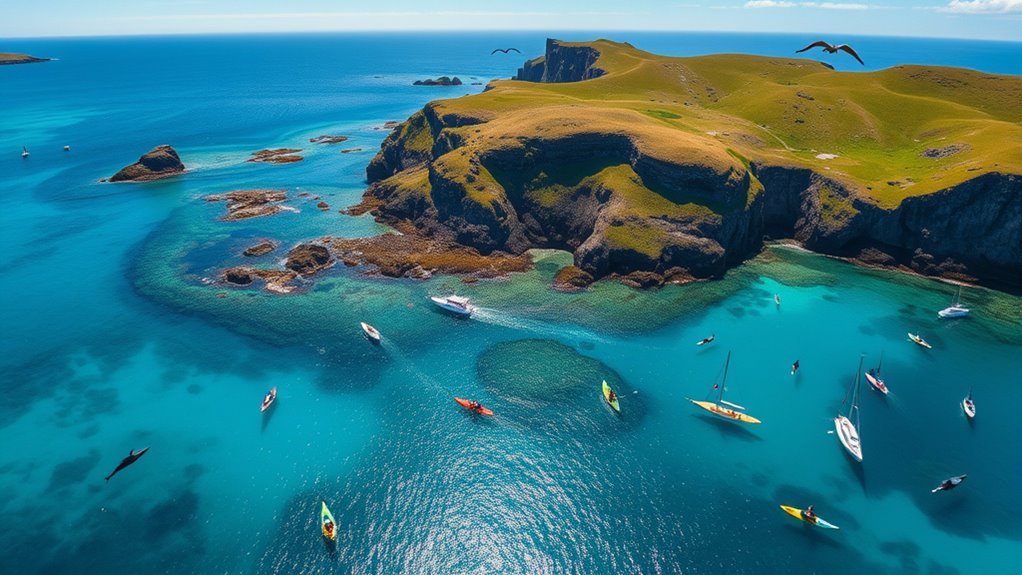
As you explore Scotland’s islands, you’ll encounter vibrant marine wildlife like seals, puffins, and dolphins. The waters also invite you to try exciting water sports such as kayaking, sailing, and paddleboarding. These activities offer a fantastic way to experience the islands’ rich aquatic environment firsthand.
Marine Wildlife Encounters
Exploring Scotland’s islands offers incredible opportunities to encounter diverse marine wildlife and enjoy water activities. As you explore, you’ll likely spot seals lounging on rocks or bobbing near the shoreline. Keep an eye out for dolphins leaping through the waves or orcas cruising past on occasion. Sea birds like puffins and gannets swoop overhead, adding to the coastal atmosphere. You might also see starfish and crabs along rocky shores or in tide pools. For a closer look, consider boat trips or guided wildlife tours, which provide chances to observe these creatures up close.
- Spot seals basking on rocks
- Watch dolphins surf the waves
- See puffins nesting on cliffs
- Discover starfish in tide pools
- Encounter orcas on rare occasions
Water Sports Adventures
Scotland’s islands are a haven for water sports enthusiasts, offering a wide range of thrilling activities set against stunning coastal backdrops. Whether you’re kayaking along rugged cliffs, paddleboarding over calm waters, or sailing into the horizon, the islands provide endless adventure. You can explore hidden coves, spot marine wildlife, or conquer waves on a surfboard. The region’s diverse marine environment makes it ideal for both beginners and experienced thrill-seekers. Here’s a quick overview:
| Activity | Highlights |
|---|---|
| Kayaking | Explore caves and remote beaches |
| Surfing | Ride powerful Atlantic swells |
| Snorkeling/Diving | Discover vibrant marine life beneath |
Get ready to plunge into unforgettable water adventures surrounded by breathtaking scenery.
The Mythology and Legends of Skye and the Hebrides
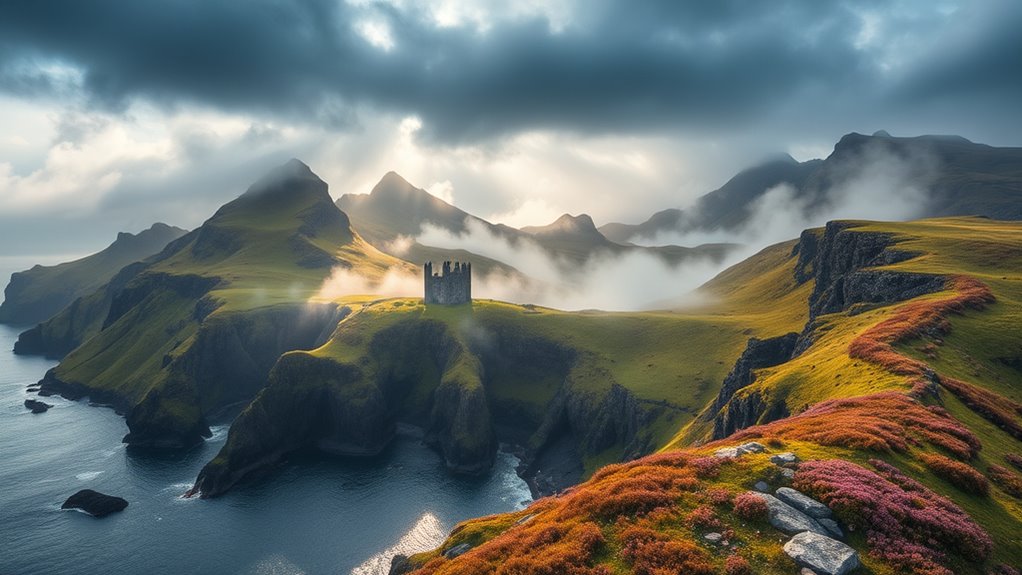
The islands of Skye and the Hebrides are steeped in enthralling mythology and legends that have been passed down through generations. As you explore, you’ll encounter stories of mystical creatures and heroic deeds that bring the landscape to life. These legends include the tale of the Kelpies—shape-shifting water horses that lure travelers into the lochs—and the mischievous Selkies, seals who can shed their skins to become humans. You might hear about the fierce battles of Scottish clans or the fairy rings said to be portals to the otherworld. Whether it’s the haunting calls of the phantom piper or the ancient stones whispering secrets, these stories add a magical depth to your journey. Immerse yourself in their rich folklore and experience the island’s mystical charm firsthand.
Discover Skye and the Hebrides’ mystical legends—from Kelpies to Selkies, enchanting tales woven into the island’s rugged landscape.
- Kelpies and water horses lurking in lochs
- Fairy rings as portals to other worlds
- Legends of brave Scottish clan warriors
- Enchanting stories of Selkies and seal folk
- Ghostly apparitions and haunted sites
Traveling Tips for Visiting Scotland’s Islands
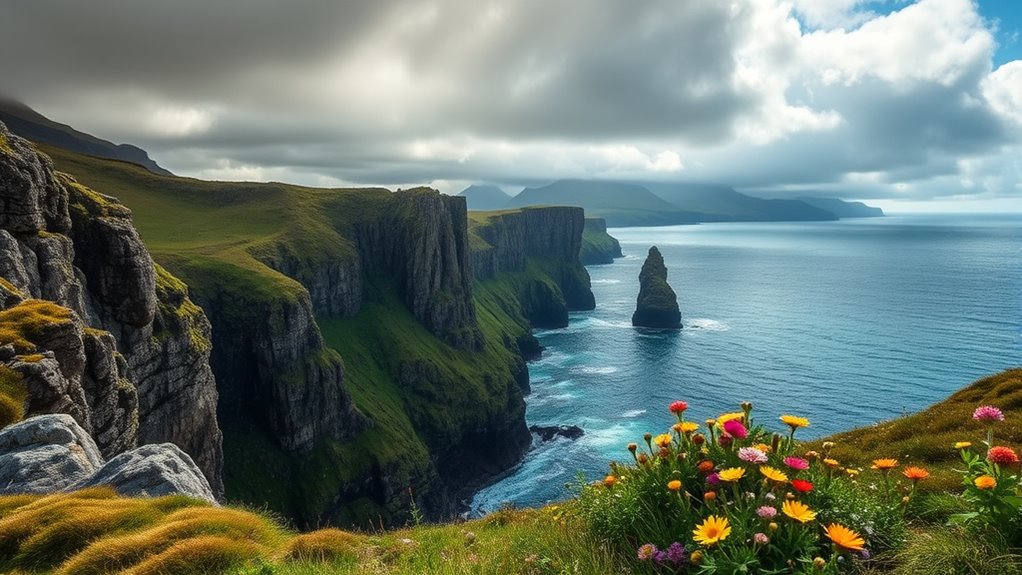
Visiting Scotland’s islands requires some preparation to make your trip smooth and enjoyable. First, plan your transportation carefully—ferries and boats are essential, so check schedules in advance to avoid surprises. Pack layers and waterproof clothing, as weather can change quickly. Bring cash, as some smaller shops and cafes don’t accept cards. Stay flexible with your plans; weather or ferry delays might alter your itinerary. Consider renting a car or bike to explore remote areas, but book early, especially in peak season. Don’t forget your camera and binoculars for wildlife sightings and stunning vistas. Respect local customs and the environment by sticking to marked paths and disposing of waste properly. With a bit of preparation, you’ll make the most of your island adventure.
Sustainable Tourism and Preserving Island Beauty
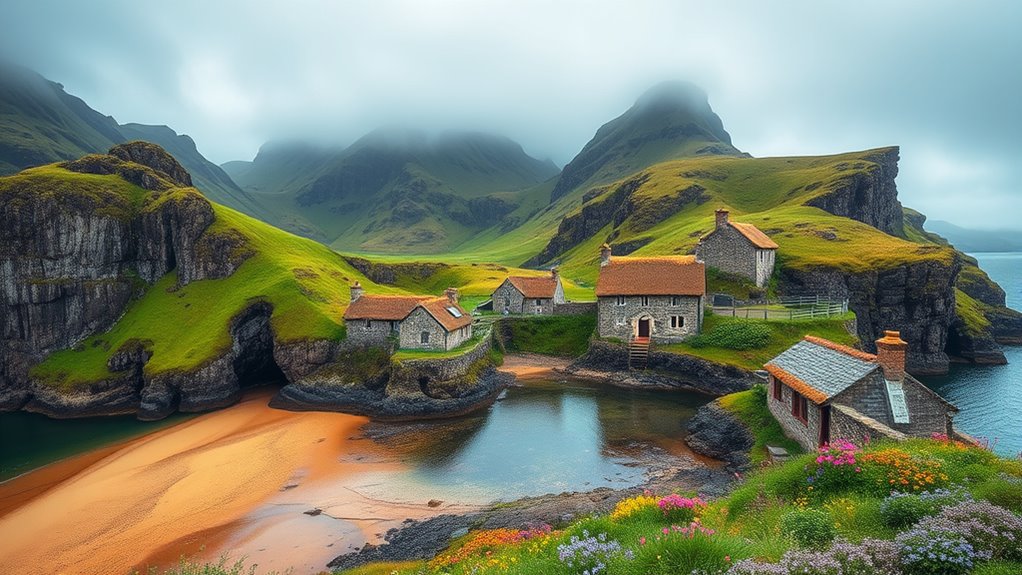
To truly enjoy the natural beauty of Scotland’s islands, it’s essential to embrace sustainable tourism practices that protect their fragile ecosystems. You can help preserve these stunning landscapes by making mindful choices during your visit. For example, respect local wildlife and stick to designated paths to prevent habitat damage. Use eco-friendly transportation options like bikes or shared rides instead of private vehicles. Support local businesses and artisans to boost the economy sustainably. Be mindful of waste—dispose of trash properly and reduce single-use plastics. Ultimately, educate yourself about the islands’ ecosystems and cultural heritage, so you can appreciate and protect their unique charm. By taking these steps, you ensure future visitors experience the islands’ beauty just as vividly as you do today.
Frequently Asked Questions
What Are the Best Times of Year to Visit Skye and the Hebrides?
You’ll want to visit during late spring to early autumn, from May to September, when the weather’s mild and the days are longer. Summer offers the best chances for clear skies and outdoor activities, but it’s also busier. Spring and early fall provide fewer crowds and stunning scenery with blooming flowers or vibrant autumn colors. Avoid winter if you prefer warm weather and reliable ferry services, as conditions can be challenging.
How Accessible Are the Islands for Travelers With Mobility Challenges?
Of course, you can easily explore every nook and cranny if you have mobility challenges—just kidding. The islands are stunning but often lack full accessibility. Some paths and facilities are limited, making it tricky for those with mobility issues. However, many tour operators now offer tailored experiences, and accessible accommodations are increasing. Planning ahead guarantees you can enjoy the breathtaking scenery without feeling left out or facing unnecessary hurdles.
Are There Local Festivals or Events Unique to Each Island?
You’ll find that each island offers its own unique festivals and events that celebrate local culture and traditions. On Skye, you might enjoy the Highland Games or local music festivals, while the Hebrides host lively seafood festivals and historic reenactments. These events provide a fantastic way to immerse yourself in island life, meet locals, and experience their rich heritage firsthand. Be sure to check event dates before your trip to catch the celebrations!
What Are the Traditional Foods and Dishes of Skye and the Hebrides?
You’ll find that traditional foods and dishes reflect the rich Scottish heritage of these islands. On Skye and the Hebrides, enjoy hearty seafood like freshly caught salmon, shellfish, and cod. You might also sample local specialties such as cullen skink, a smoky fish soup, and oatcakes. Don’t miss traditional stews and hearty dishes that use locally sourced ingredients, offering you a delicious taste of island life.
How Do I Get Around the Islands Without a Car?
Getting around without a car is totally doable. You can use local buses that connect major towns and villages, making travel affordable and convenient. Ferries are also essential for reaching remote islands or exploring different parts of the archipelago. Additionally, cycling is a great option if you’re up for it, offering a flexible way to see the scenery at your own pace. Always check schedules in advance to plan your trip smoothly.
Conclusion
Exploring Scotland’s islands offers unforgettable adventures, from rugged landscapes to rich cultural traditions. As the saying goes, “A journey is best measured in friends, not in miles.” Embrace the beauty and stories of Skye and the Hebrides, but remember to tread lightly and safeguard their magic for future explorers. Your visit helps ensure these stunning islands remain a treasure for generations to come.



